ON-GOING PROJECTS
RIOT: REHABILITATION USING INTERNET OF THINGS
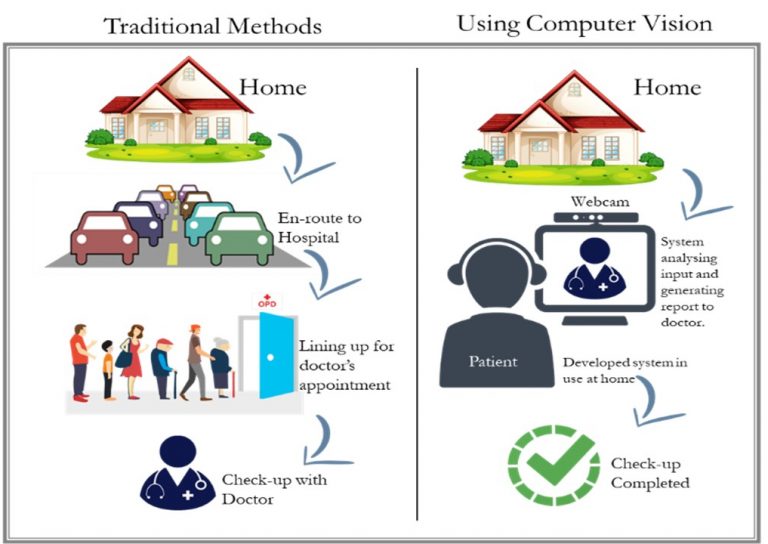
Abstract:
Computer vision is advancing swiftly and giving valuable answers in our daily lives, notably in health; its use is desirable. Rehabilitation patients must routinely visit their doctors to check on the progress of their physical, which involves hand stretches. This has become troublesome and time-consuming as most time is spent travelling from home to rehabilitation centers. We can use computer vision to follow this progress virtually instead, and this project captures how much the hand is stretched and translates it to volume in percentage. This technique will eliminate the need for patients to travel to hospitals for rehabilitation, allowing them to do it at home. The device uses a webcam coupled to a computer and a Python software to overcome the trip challenge. The system leverages Multimedia Development Life Cycle (MDLC) as its proposed technique, first recognizing a patient's hand via the webcam, then picking up the thumb and index finger points to aid the stretch distance, which is subsequently translated to volume. The patient merely needs to plug in a webcam, run the program, and stretch their palm 30cms away from the camera for optimal accuracy. The system tested well, picking up hand points and displaying volume dependent on hand stretch in real time. The innovative solution solves the travel barrier to hospitals for rehabilitation, allowing patients to relax without anxiety.
MQTT-ENABLED SMART DOOR ACCESS SYSTEM
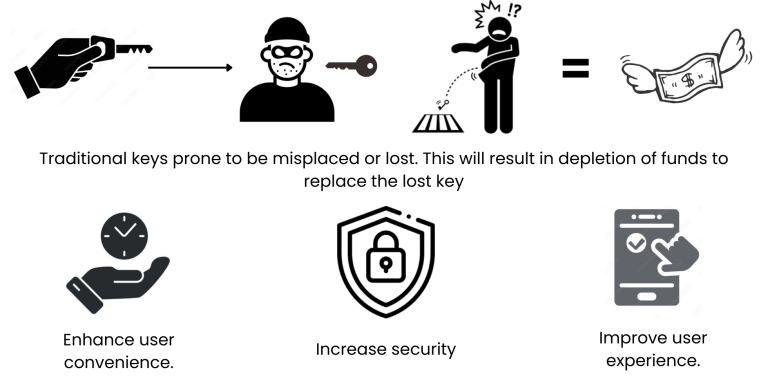
Abstract:
The security of one's residence or property is an essential consideration that warrants careful attention to safeguard the premises and its contents. It has become increasingly apparent today that physical key door locks are susceptible to damage and can be compromised by unauthorized individuals. The inherent vulnerability of physical key door locks stems from their susceptibility to misplaced keys and duplication, as individuals are required to always carry them. This work presents a novel Internet of Things (IoT) enabled smart door access system designed to improve the security of homes or premises. The system offers keyless access to individuals who have been granted authorization. The system's architectural design incorporates the utilization of a NodeMCU ESP 8266 microcontroller to oversee door operations. Access control functionality is facilitated through the implementation of the Virtuino IoT application, which enables the unlocking of doors using smartphones. Additionally, a MQTT broker, specifically the HiveMQ, is implemented to facilitate effective machine-to machine communication within the IoT components. The rationale behind the adoption of this IoT-based solution stems from the inherent weaknesses of traditional physical key door locks, which are prone to damage and replication, consequently jeopardizing security measures. The proposed system aims to address these limitations by rendering traditional keys obsolete, thereby improving both security and convenience for users. The system has undergone comprehensive development, testing, and operationalization, resulting in a highly functional system. The success rate of all functions has consistently achieved a 100% level, which serves as an indication of the system's robustness and effectiveness. In addition, the practical implementation of the system in the Centre of Excellence for Cybersecurity (CoExCys) office at Kulliyyah of ICT HUM exhibited smooth operation and the absence of any operational challenges throughout a trial period lasting one week. The findings highlight the potential of the system as a feasible solution for enhancing security and regulating access in diverse environments.
COBOT: SMART ATTENDANCE SYSTEM BASED ON AUTONOMOUS CAR
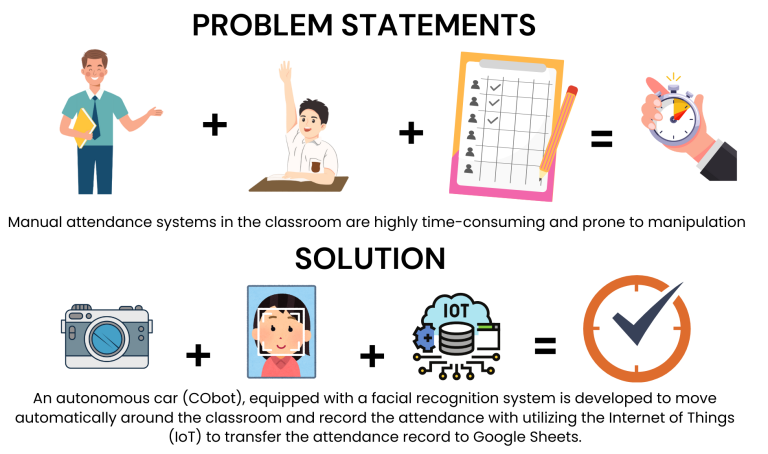
Abstract:
Current attendance methods are simple, however it is prone to manipulation and time-consuming for educators and students. For example, manual attendance system and QR code scanning allow students to register attendance for their friends since these methods lack unique identification. Increasing security by calling students names one by one is more secure but disrupts the learning process by consuming a lot of time. This study aims to minimize manipulation in attendance and ensure a better learning experience. An autonomous car (CObot) equipped with a facial recognition system powered by a Raspberry Pi microcontroller is developed to move automatically around the classroom, avoiding obstacles. This approach saves time in the attendance process by eliminating the need for students or educators to move around. Using facial recognition ensures that only registered individuals can mark their attendance, resulting in a more secure system. For better bookkeeping, the autonomous robot utilizes the Internet of Things (IoT) to transfer attendance data to Google Sheets, easing the educator's workload by saving space and making records easier to trace. The use of 3D printing allows for customizable car structures. Compared to other microcontrollers like the ESP32-S3, the Raspberry Pi 5 is chosen for its superior processing power and data transfer speeds, ensuring a smoother process for data analysis and transfer. This CObot aims to enhance the classroom environment by benefiting both students and educators. Although seamless attendance processes may seem like a small contribution, CObot is significant in ensuring a better learning environment. In an experiment with 60 participants, the ESP32-S3 achieved a 90% accuracy rate in facial recognition, whereas the Raspberry Pi 5 achieved a 99% accuracy rate. Consequently, the Raspberry Pi 5 not only processes information faster but also provides a more secure and accurate facial recognition system.
HABs: MODELLING OF HARMFUL ALGAE BLOSSOMS
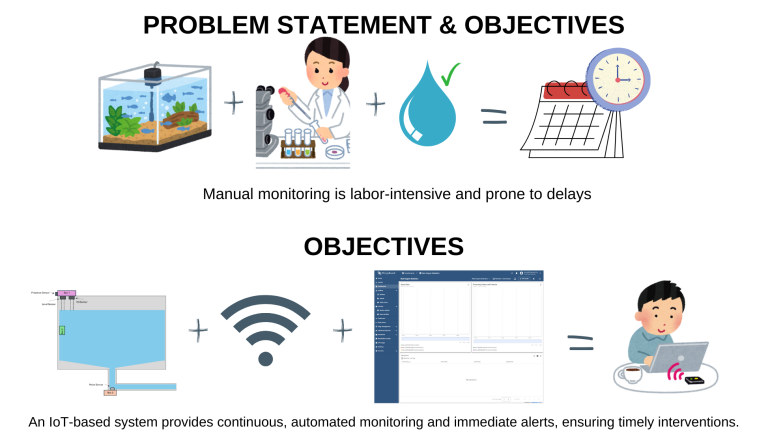
Abstract:
The aquaculture industry is highly dependent on maintaining optimal water quality to ensure the health and productivity of aquatic organisms. Traditional methods of monitoring water quality are often labour-intensive, time-consuming, and more inclined to delays in detecting harmful changes. This project addresses these challenges by developing a real-time, automated monitoring system using IoT technology and ThingsBoard for data visualization. The primary motivation for this project is to enhance the efficiency and reliability of water quality monitoring in aquaculture settings. Key water parameters such as temperature, dissolved oxygen, and turbidity levels are crucial for the well-being of aquatic life. Deviations from optimal conditions can lead to severe consequences, including disease outbreaks and high mortality rates. Thus, there is a significant need for a system that can provide continuous, accurate monitoring and timely alerts to aquaculture operators. The methodology involves the integration of various water quality sensors with microcontrollers such as the ESP8266 and ESP32 that perform edge computation to process data locally. This reduces the dependency on cloud computation and ensures faster response times. Data from the sensor nodes are transmitted via Wi-Fi communication modules to ThingsBoard, an open-source IoT platform. ThingsBoard serves as the centralized hub for data visualization, providing real-time dashboards, historical trends, and alert notifications. By implementing this IoT-based solution, the project aims to deliver a scalable and cost-effective water quality monitoring system. The use of ThingsBoard for dashboard visualization enhances the user experience by providing intuitive and actionable insights. This system not only improves the operational efficiency of aquaculture farms but also contributes to the sustainability and productivity of the aquaculture industry
EARLY FLOOD DETECTION AND MONITORING SYSTEM
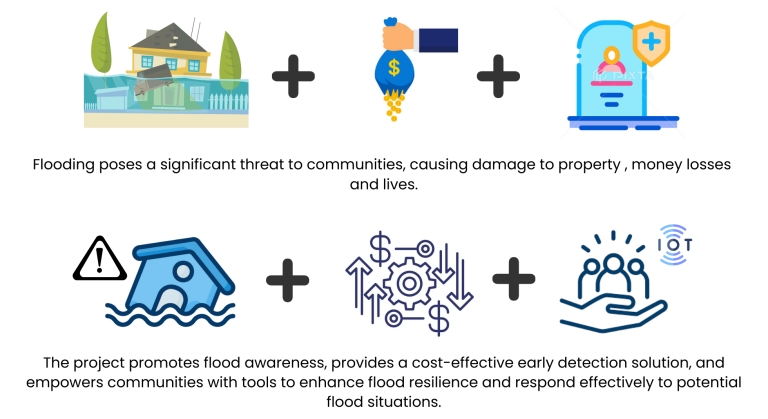
Abstract:
Flooding is a recurrent natural catastrophe in Malaysia, demanding excellent early warning and monitoring systems to reduce the impact on those affected. Traditional flood monitoring systems have severe limitations, including reliance on human data gathering, a lack of real-time capabilities, expensive prices, and slow response times, particularly in developing countries. To solve these issues, this research aims to design an Early Flood Detection and Monitoring System that uses Internet of Things (IoT) technology to provide a cost-effective, efficient, and real-time solution for detecting increasing water levels and sending early alerts. The system uses commonly accessible components such as NodeMCU ESP8266, Ultrasonic Sensors, and MAX7219 Dot Matrix Displays to build a sensor network in flood-prone locations. These sensors continually send data to a central processing unit for analysis, and a machine learning model based on Time Series forecasting is used for predictive analysis in the ThingSpeak platform, which is available via an internet dashboard for real-time monitoring. Testing revealed that the system efficiently monitors water levels and sends timely alerts, hence increasing flood readiness and response. Its real-time monitoring capacity guarantees communities receive early information, allowing for proactive flood risk mitigation actions. This study presents a scalable and sustainable solution for improving flood monitoring efficiency and reliability, addressing the limitations of traditional systems and significantly advancing flood preparedness and resilience, thereby supporting effective flood mitigation in resource-constrained environments.
SMART WATERING SYSTEM USING NODEMCU ESP8266
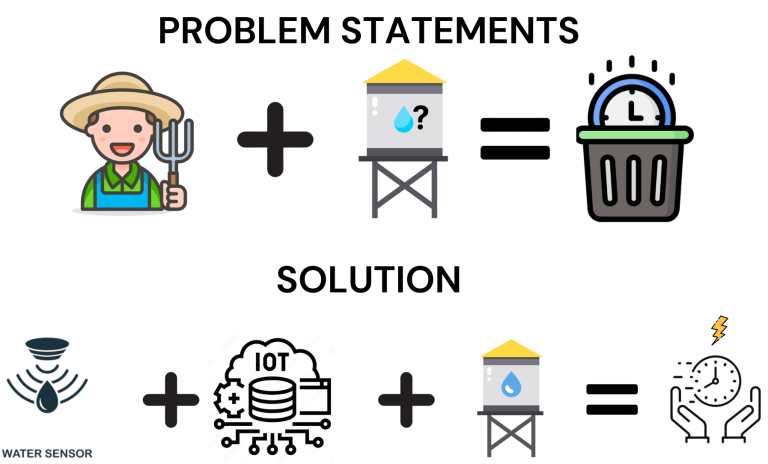
Abstract:
Small scale agriculture setting faces challenges such as efficiently managing and monitoring water levels in the water tank for the reason of providing water to plants, which will lead to water wastage and insufficient supply. The traditional method is checking water levels frequently to ensure the level of the tank is at the satisfactory level, nevertheless such processes are time- consuming and prone to human error. This project aims to develop a water level monitoring system that is capable of providing real-time data and to provide reminders to the user to check on the water tank when it reaches below unsatisfactory level. An automated water level monitoring system, by implementing Internet of Things (IoT), such as microcontroller NodeMCU ESP8266 because of the ability to interact and send data through the internet and the Blynk app, a platform design for IoT applications that allows user to create and manage connected devices, a LCD for the user to see the level of the water at the satisfactory or unsatisfactory level, and few components such ultrasonic sensor, water pump,relay module that is needed for the water level monitoring system to become automated. This project offers a scalable and sustainable approach to enhancing the efficiency and reliability of the monitoring water level and substantially saves time and proficiency in regulating water level.
